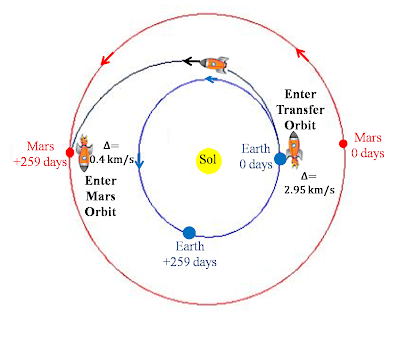-
 @ Komi_Hartman
2024-07-10 09:05:34
@ Komi_Hartman
2024-07-10 09:05:34Imagine a cosmic slingshot that flings your spacecraft towards distant planets with minimal effort. That's the essence of a Gate Orbits, strategically chosen circular orbits around celestial bodies, that significantly reduces the fuel required for interplanetary travel.
Benefits of Gate Orbits
- Reduced Delta-V:
Heavier Payloads: Lower fuel needs translate to more space for scientific instruments, supplies, or even crew members on future missions. Smaller Launch Vehicles: Lighter payloads equate to less powerful & potentially reusable, launch vehicles.
- Cost Efficiency:
Lower fuel requirements & increased payload capacity can lead to substantial cost savings. Smaller, less expensive launch vehicles can be used & the reduced need for frequent resupply missions can lower operational costs.
Envisioning Gate Orbits in Action:
"Interplanetary mission design has seen significant advancements beyond traditional Hohmann transfer orbits"...
Well, consider a trip from Earth to Mars. A traditional Hohmann transfer orbit might require a 'Δv' of 2.94 km/s. By launching from an Earth Gate Orbit, the spacecraft could achieve escape velocity with a 'Δv' of only 2.08 km/s! This translates to a potential 62% increase in payload capacity or a significant reduction in launch vehicle size & cost.
N.B. Mars Gate Orbit can be calculated at ((2x398’600/2.943^2=) 92’042 km radius. When in circular orbit at this distance from Earth, a vehicle will require an additional velocity of (√(2.943^2/2)=) 2.08 km/s to inject into a Hohmann transfer to Mars.

Power of Gate Orbits: Using Math to Understand Efficiency Gains
The concept of Gate Orbits becomes even more impactful when we delve into the mathematics of rocket propulsion. That's how Delta-V (Δv) equation sheds light on the efficiency benefits of Gate Orbits:
Tsiolkovsky Rocket Equation relates the maximum change in velocity (Δv) of a spacecraft to its initial mass (𝑚0), final mass (𝑚𝑓) & the effective exhaust velocity (𝑣𝑒). It essentially tells us how much a rocket can accelerate based on its fuel & engine efficiency: Δ𝑣 = 𝑣𝑒 ln 𝑚0/𝑚𝑓
The equation reveals a critical truth!!! Why??? Simply, the required initial mass (𝑚0) grows exponentially with the desired 'Δv'. Which means, small increases in the desired final velocity translate to a significant increase in the amount of propellant needed. That's why traditional interplanetary missions require such massive rockets, as they need to carry enough fuel to achieve the necessary 'Δv' for escape velocity.. And this is where Gate Orbits come in!

Challenges & Future of Gate Orbits
Traveling to other planets demands immense speeds to escape a planet's gravitational pull & set a trajectory towards the destination. This speed change, known as delta-v (Δv), is a crucial factor in spacecraft design. The higher the Δv required, the more fuel a spacecraft must carry, leading to heavier & more expensive missions... While theoretically sound, Gate Orbits present challenges:
-
Precise Orbital Insertion: Reaching & maintaining the specific Gate Orbit requires precise maneuvers. Advanced navigation & guidance systems are crucial.
-
Infrastructure Development: Establishing infrastructure, like refueling stations or temporary staging areas, at these specific locations might be necessary for certain missions.
Looking Forward....
- Relationship to Ion Rockets & Delta-V
Ion rockets, with their incredibly high specific impulse (Isp), offer another avenue for fuel-efficient space travel. However, their low thrust makes them unsuitable for lifting off from planets. Gate Orbits can be particularly beneficial for missions utilizing ion drives. By providing a gravitational boost at the outset, Gate Orbits allow ion-powered spacecraft to capitalize on their high Isp for efficient interplanetary travel. (Recent innovations in interplanetary mission design, such as non-Hohmann transfers utilizing low-thrust propulsion, ballistic trajectories & resonant orbits, provide more efficient & flexible mission profiles.)
- Lunar Missions with Gate Orbit Concept
Near Rectilinear Halo Orbits (NRHO): Proposed for the Lunar Gateway, these orbits provide a stable platform for sustained lunar operations. NRHOs offer continuous line-of-sight communication with Earth & reduced fuel requirements for station-keeping. Support both lunar surface missions & deeper space exploration. The Lunar Gateway will serve as a staging point for missions to the Moon's surface, particularly the South Pole, & as a testing ground for technologies needed for Mars missions.
How ? The Lunar Gateway as a 'gate orbit' facilitates lunar landings & acts as a hub for assembling spacecraft bound for Mars or other destinations. It enables modular mission design, where components are launched separately & assembled in orbit.
Mission Sequence
To better understand the practical application of Gate Orbits, consider the following mission sequence:
1- Launch: The spacecraft is launched from Earth into a low Earth orbit (LEO).
2- Gate Orbit Insertion: The spacecraft performs a maneuver to enter the specific Gate Orbit around Earth.
3- Slingshot Maneuver: Using the gravitational influence of Earth, the spacecraft receives a velocity boost, reducing the Δv required from its own engines.
4- Interplanetary Cruise: The spacecraft continues its journey to its interplanetary destination, such as Mars, with significantly reduced fuel consumption.
With the increasing focus on space exploration & the potential for future human habitation on other planets, efficient interplanetary travel methods become even more critical.. Gate Orbits offer a transformative approach to space travel, reducing fuel requirements & expanding mission capabilities. By leveraging the gravitational forces of celestial bodies, they provide an efficient pathway for deep space exploration.